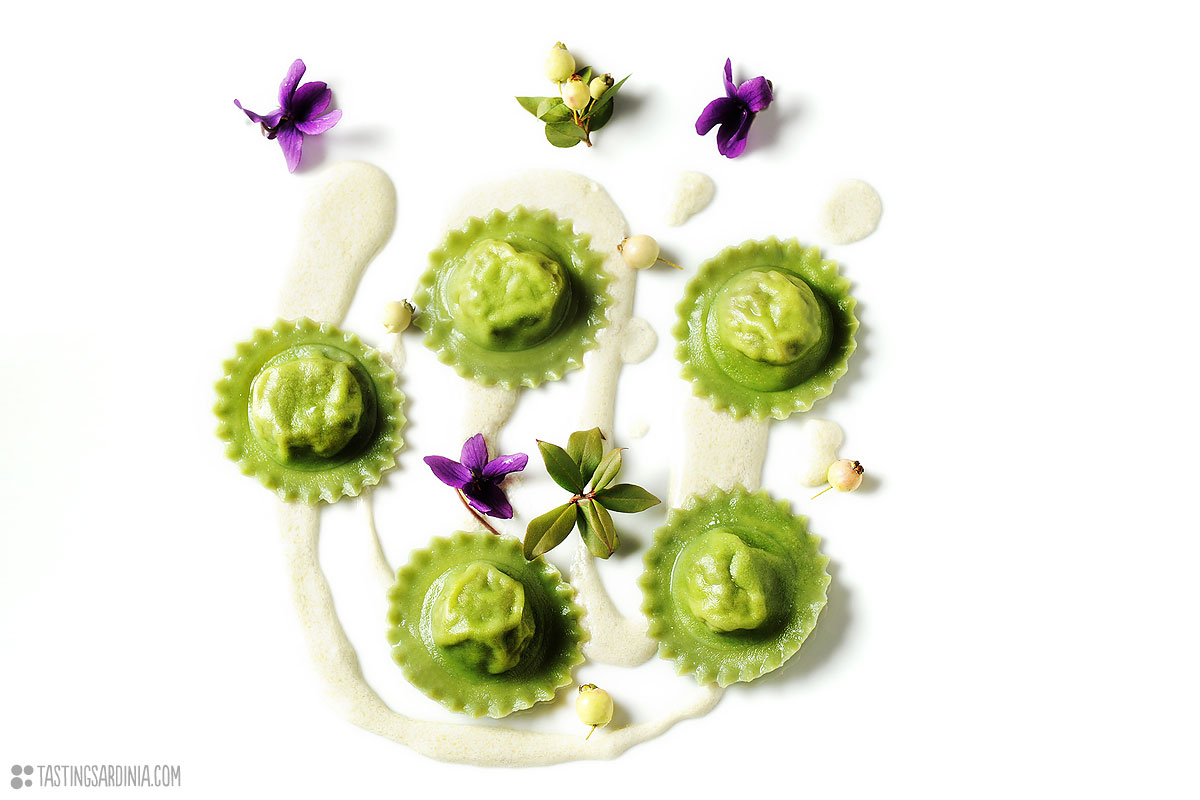prep time: – cook time:
Ravioli are the quintessential tasty meal and perfect any time of the year. These were kneaded using spinach in order to make a green dough and stuffed with a mixture of asparagus, anchovies paste, radicchio and toasted bread crumbles. For the seasoning I took inspiration from a traditional way of dressing the ravioli with butter and sage leaves: a sauce or Italian besciamella made with butter, milk cream and myrtle leaves. What a combination, each flavor will be perfectly recognizable and well balanced.
- 300 gr 00 flour
- 200 gr semolina flour
- 3 eggs
- 300 gr spinach
- salt to taste and water
Ingredients seasoning and filling
- 100 gr asparagus
- anchovies paste
- 100 gr radicchio (red leafed chicory)
- toasted bread crumbs
- olive oil
- 30 gr butter
- some myrtle leaves
- 50 gr milk cream
- 1 clove of garlic
- salt to taste
Directions
Clean and steam the spinach until is just wilted. In a large bowl combine together the 00 flour, the semolina flour, the eggs and the steamed spinach. Add gradually some water paying attention not to pour too much, the steamed spinach is already wet. Knead the dough carefully for 40 min. at least trying to roll it back and stretch it forward as much as possible. The dough will result more resilient and workable avoiding the risk to have the ravioli smashed-broken while boiling. Wrap the ravioli pasta with a tea cloth and put it in the fridge for a 30 min. rest.
Clean the vegetables for the filling. Stew the chopped spinach with few drops of olive oil and a clove of non chopped garlic. Once it has sautéd for a while and the garlic is goldening up add the chopped radicchio. Try to keep the lid on in order not to pour any more water, the filling should be kept as dry as possible. When the radicchio is wilted add some anchovies paste to taste.
Separately in a non-sticky frying pan toast some bread crumbles until they are brown and smell like fresh bread. Combine the toasted bread crumbs with the rest of the filling making sure it has the right consistence, it should be possible to make balls with your hands and adjust with salt.
Roll out the dough with the rolling pin or a dough sheeter, trying to get a very thin layer, it should be the thinest setting. Form the filling balls with your hands and place them on the pasta layer, cover with another layer and cut the layered dough with a round-ravioli-stamp to make a nice shape. Place them on a surface previously spread with 00 flour.
Make the sauce melting the butter on a large pan and keep some myrtle leaves in it until it is flavored. Add the milk cream a stir for a while. When the dressing is well creamy boil the ravioli in salted water for 3 minutes. You are ready for serving.
Serving
This dish is clean and simple, I personally prefer to keep it as graceful as possible not pouring the besciamella on the top of the ravioli. I have placed some myrtle berries and leaves to give an hint about ingredients and flavours. The violets were helpful to add contrast; they are not edible and some chefs could find it a blunder: it’s not my fault if I love photography.
Grandmother’s tip
I have always read that to make a good colored dough you should observe the right order while adding the ingredients. By the way I am not capable of offering a scientific explanation but meanwhile can assure that it works better. The precise order to follow should be: 00 flour; semolina flour; eggs; salt; afterwards you knead the dough and add some water if necessary.
My own way
Ravioli in Sardinia come in different shapes and with variables fillings. But most of them are traditionally seasoned with tomato sauce on top or similar. The combination is a good match for sure but in some cases I love to use something more discreet and restrained to give importance to the filling taste and to the ravioli shape. This besciamella cream made with myrtle, butter and milk cream is an invention of mine and I took inspiration from a very delicate and simple sauce that was stolen from the main Italian tradition: butter and sage leaves.
Myrtle (sa murta as it is known in Sardinia), is a small to medium-sized woody shrub. The berries, that could be white or purple according with the different variety are used to make a very popular Sardinian liqueur that brings the same name: mirto. It is obtained from the myrtle plant through the alcoholic maceration of the berries or a compound of berries and leaves. Myrtle grows freely in Sardinia, where the liqueur was consumed as part of a local niche market; legend has it that, long ago, Sardinian bandits introduced this particular usage of the plant to the nearby island of Corsica, where the liqueur has also been considered a traditional drink since then.
The plant with its leaves is also used to wrap up the still warm roasted piglet to give it an unmistakable aroma. This recipe is ideally considered to be the signature dish of the entire Sardinian culinary tradition.
[kkratings]








